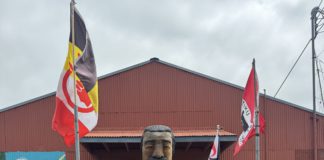
Both my great-grandfathers immigrated to Watsonville in the 1850s. Not long after they first arrived, they were introduced to one of our region’s greatest threats to lives and livelihoods: flooding from the Pajaro River and its tributaries. Soon after arriving, my great-grandfather Stephano Martinelli, a farmer by trade, planted a wheat crop along the Pajaro River. Within a year, he lost his investment to a flood, so he went to work for his older brother Luigi, who was growing apples on what is now Martinelli Street. Although that twist of fate worked out for my family, many others were not so lucky. My grandfather Floyd Silliman farmed my mother’s family ranch, between Riverside Road and the river, which flooded regularly over the first 100 years, rendering half the acreage unfarmable.
To prevent repeated flood events, the U.S. Army Corps of Engineers built earthen levees along the river and creeks in 1945, which are still in place and relatively unchanged today. Ten short years later, people were rowing boats down Main Street following a levee failure caused by a 25-year storm on the Pajaro River and Corralitos Creek. Our Community has suffered seven significant flood events since 1955, with a very near miss on the eighth in 2017. The existing levees have proven time and again to be woefully inadequate, and are rated at among the lowest level of flood protection in the state and nation.
We have a 40 percent chance of suffering a 25-year flood event in the next 10 years. The Corps estimates a major flood on the Watsonville side would cause $1 billion in damages. A flood of that magnitude would devastate our company by destroying our finished goods inventories, which cannot be replaced until the next apple harvest season. Damage to buildings and equipment could take over a year to rebuild, and the inability to supply products to the marketplace would result in lost grocery shelf space that may never be regained. The resulting loss of our employees’ homes and livelihood, multiplied across every employer in our downtown Community, would destroy our local economy for many years to come. Flood insurance simply cannot come close to covering the true cost of these damages, and when the project is completed, we will not be required to pay for flood insurance anymore.
Back in the day, my grandfather Silliman was a road builder, in addition to being a farmer. He and his farmer friends along the river, used massive bulldozers to clean out the river bottom every year, to maintain its designed floodwater capacity. Even then, the flood control channel barely did its job. Today, we are no longer allowed to scrape the channel clean, due to environmental regulations and permitting. The growth of vegetation restricts the flow capacity, and rebuilding the levee system with increased width and height, is the only way to contain flood waters.
Levee maintenance services are currently underfunded. The newly formed Pajaro Regional Flood Management Agency is taking over responsibility for levee maintenance on behalf of the counties to provide long-term cost savings through economies of scale, and administrative efficiencies, and ensure an increased commitment to levee and channel maintenance. Toward that end, the Agency is proposing an annual assessment of 3,000 properties, that benefit from flood protection through levee maintenance activities, to bridge a $1.2 million shortfall between existing and needed revenues dedicated to levee maintenance. This local guarantee to maintain the current and future levee system is a requirement to obtain the capital funding needed to rebuild the levees.
Maintaining what we have is critical, but improving levees is key to a flood-free future. The US Army Corps of Engineers and the state are promising to fully fund the $400 million Pajaro River Flood Risk Management Project, which will modernize levees along the river and creeks and provide protection against a 100-year flood event. Typically, projects like these require a 10% local cost share. But, our share is being covered by the state, thanks to legislation passed by our state delegation. As a result, this is the first project of its kind in California in which the state and federal governments are paying 100% of the construction costs. However, in order to sign the funding agreements, the Agency must demonstrate its ability to adequately fund levee maintenance, now and in the future.
If the assessment is not approved by property owners, the Agency can’t sign the funding agreements and we’ll lose a once-in-a-lifetime chance to protect our properties from flooding. Additionally, our current levee maintenance program will remain underfunded, so our existing levels of flood protection will continue to deteriorate.
Assessment ballots were sent to affected property owners on April 22. When yours shows up, please protect your property and community by checking the yes box and sending it in.
S. John Martinelli is the Chairman of the Board for S. Martinelli & Company.











